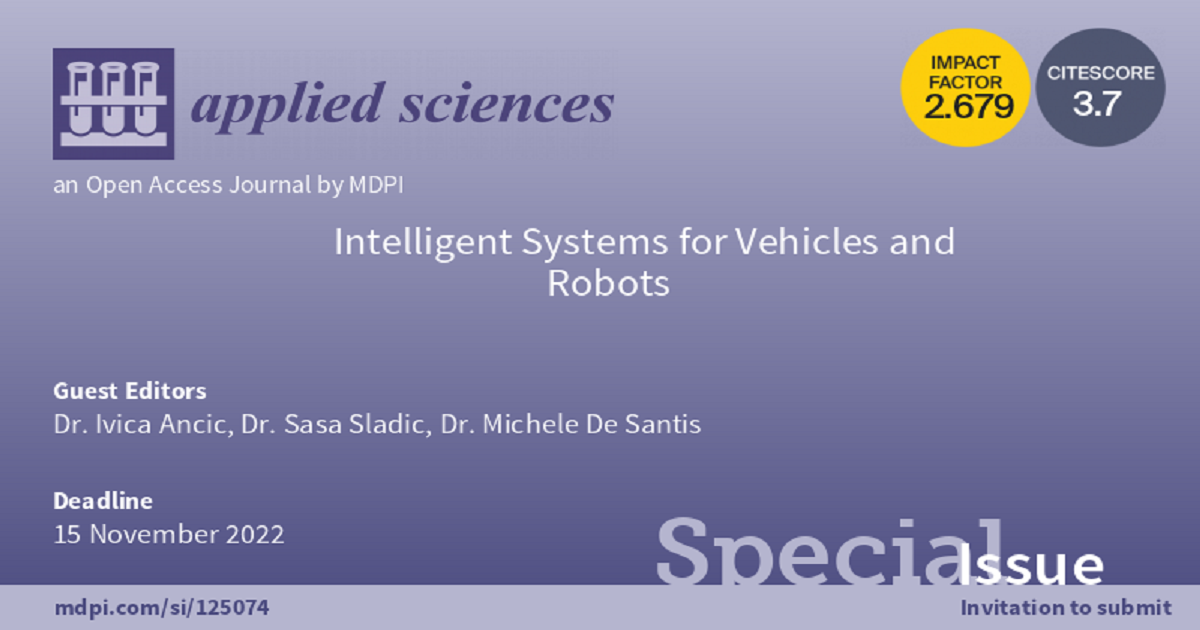Intelligent Systems for Vehicles and Robots
A special issue of Applied Sciences (ISSN 2076-3417). This special issue belongs to the section "Robotics and Automation".
Deadline for manuscript submissions: closed (15 May 2023) | Viewed by 3960

Special Issue Editors
Interests: energy and environmental characteristics of marine power systems
Special Issues, Collections and Topics in MDPI journals
Interests: power electronics; electric drives; mechatronics; wind energy conversion systems; photovoltaic systems; power electronics applications
Special Issues, Collections and Topics in MDPI journals
Interests: voltage control in distribution networks; power quality; e-mobility
Special Issues, Collections and Topics in MDPI journals
Special Issue Information
Dear Colleagues,
Autonomous or self-driving vehicles have been considered part of our technological future for decades. First, automatic emergency braking (AEB) and forward collision warning (FCW) systems appeared. Autonomous driving also requires the integration of blind spot detection, lane departure warning, lane keeping assist and lane centering assist for heavy commercial vehicles with older systems such as anti-lock braking systems (ABSs). This problem is basically programing oriented; however, hardware solutions including new sensors and wide-bandgap (WBG) electronic and mechatronic solutions are also welcomed. Similar trends to those which are present in vehicles can also be found in robotics. That is a consequence of the wide influence of intelligent systems. For instance, modern industrial robots must operate at high speeds. The presence of fast-moving objects means danger for nearby humans, and so industrial robots are usually physically isolated. At the same time, different applications demand a high level of security to operate with humans. These types of applications can be found in education, medicine and in production. Such demands on robots are quite similar to those in traffic, and the development of intelligent solutions should improve the security and reliability of existing systems. Contributions connected with these topics are welcomed to this Special Issue.
Dr. Ivica Ancic
Dr. Sasa Sladic
Dr. Michele De Santis
Guest Editors
Manuscript Submission Information
Manuscripts should be submitted online at www.mdpi.com by registering and logging in to this website. Once you are registered, click here to go to the submission form. Manuscripts can be submitted until the deadline. All submissions that pass pre-check are peer-reviewed. Accepted papers will be published continuously in the journal (as soon as accepted) and will be listed together on the special issue website. Research articles, review articles as well as short communications are invited. For planned papers, a title and short abstract (about 250 words) can be sent to the Editorial Office for assessment.
Submitted manuscripts should not have been published previously, nor be under consideration for publication elsewhere (except conference proceedings papers). All manuscripts are thoroughly refereed through a single-blind peer-review process. A guide for authors and other relevant information for submission of manuscripts is available on the Instructions for Authors page. Applied Sciences is an international peer-reviewed open access semimonthly journal published by MDPI.
Please visit the Instructions for Authors page before submitting a manuscript. The Article Processing Charge (APC) for publication in this open access journal is 2400 CHF (Swiss Francs). Submitted papers should be well formatted and use good English. Authors may use MDPI's English editing service prior to publication or during author revisions.
Benefits of Publishing in a Special Issue
- Ease of navigation: Grouping papers by topic helps scholars navigate broad scope journals more efficiently.
- Greater discoverability: Special Issues support the reach and impact of scientific research. Articles in Special Issues are more discoverable and cited more frequently.
- Expansion of research network: Special Issues facilitate connections among authors, fostering scientific collaborations.
- External promotion: Articles in Special Issues are often promoted through the journal's social media, increasing their visibility.
- Reprint: MDPI Books provides the opportunity to republish successful Special Issues in book format, both online and in print.
Further information on MDPI's Special Issue policies can be found here.







